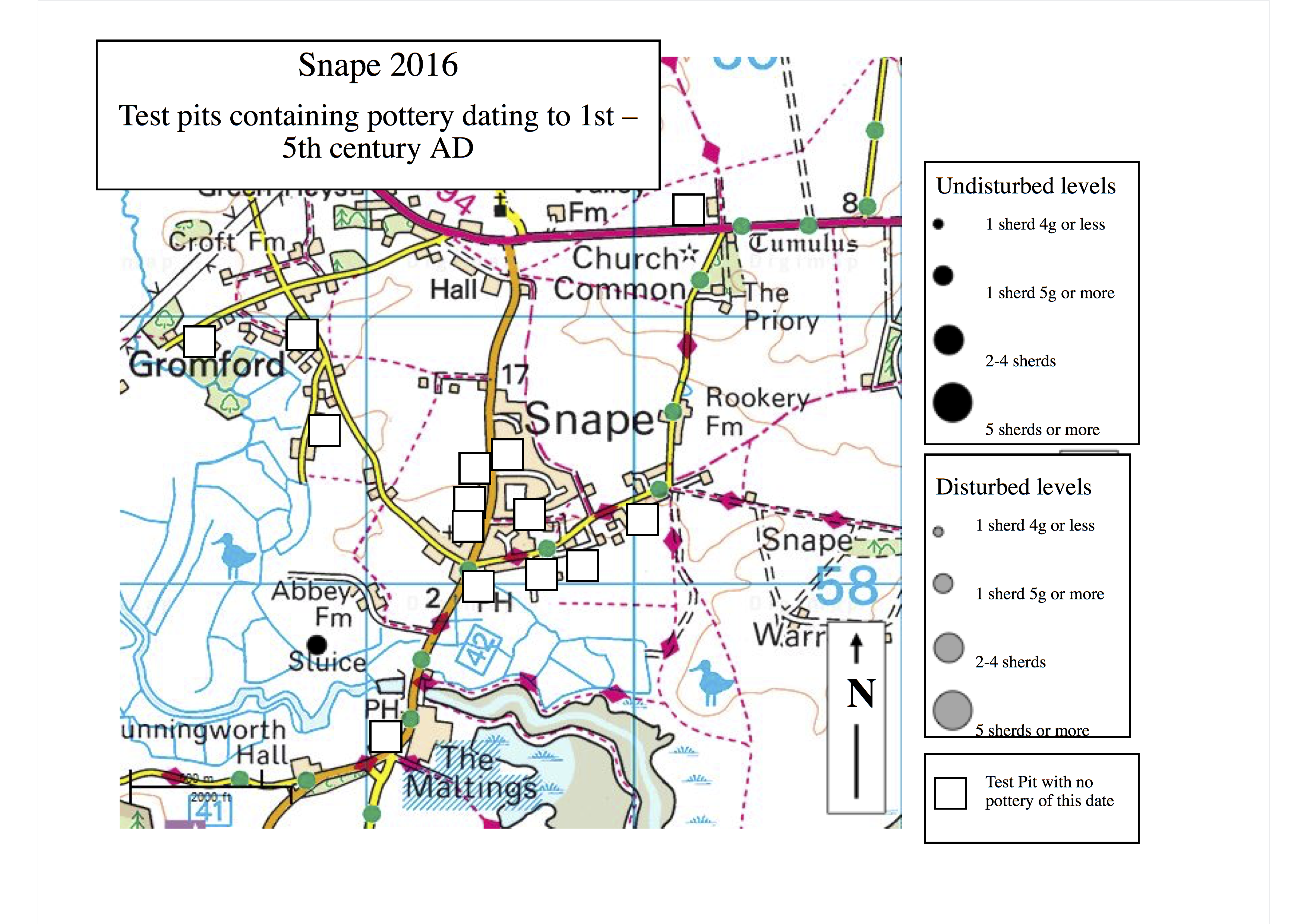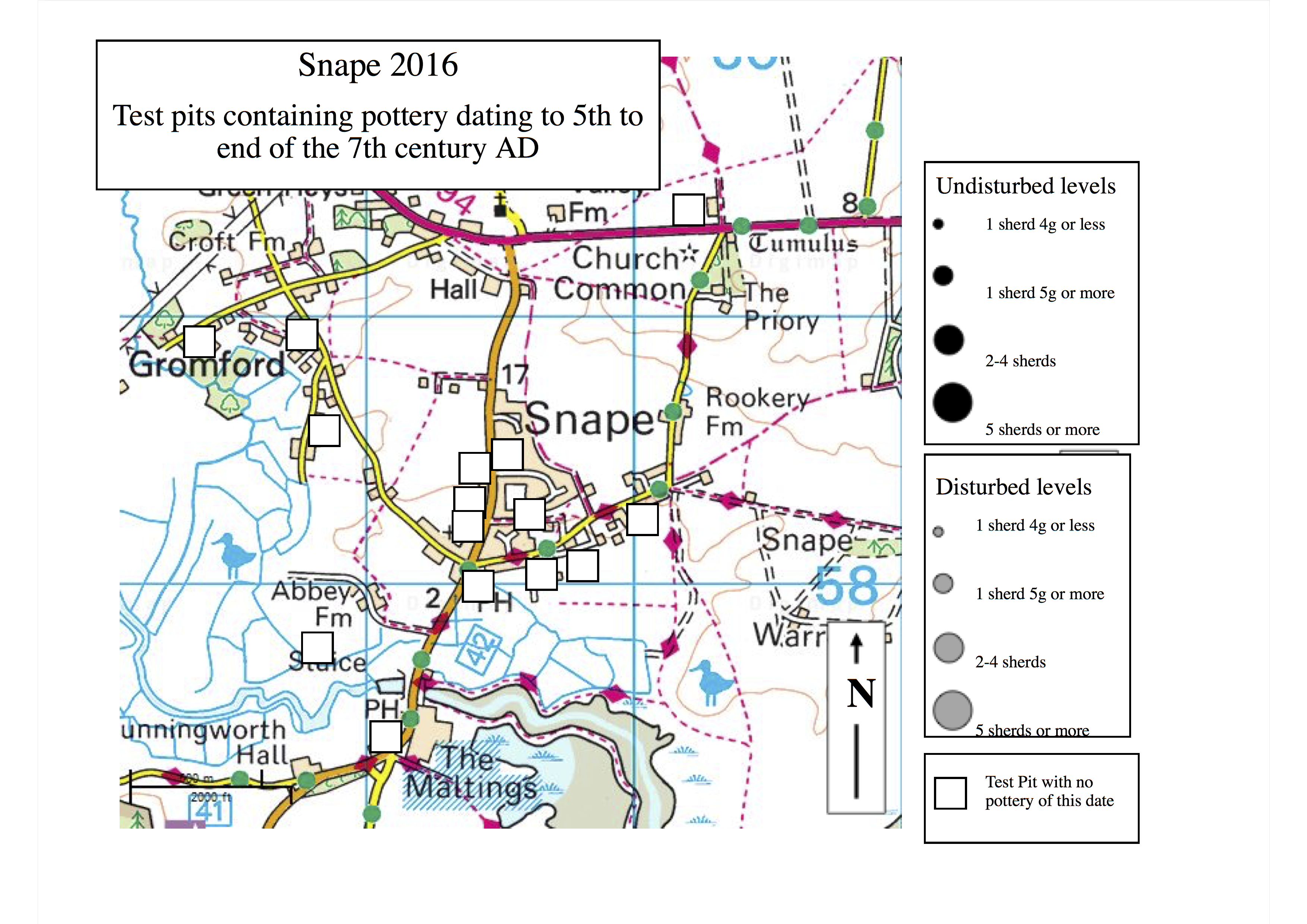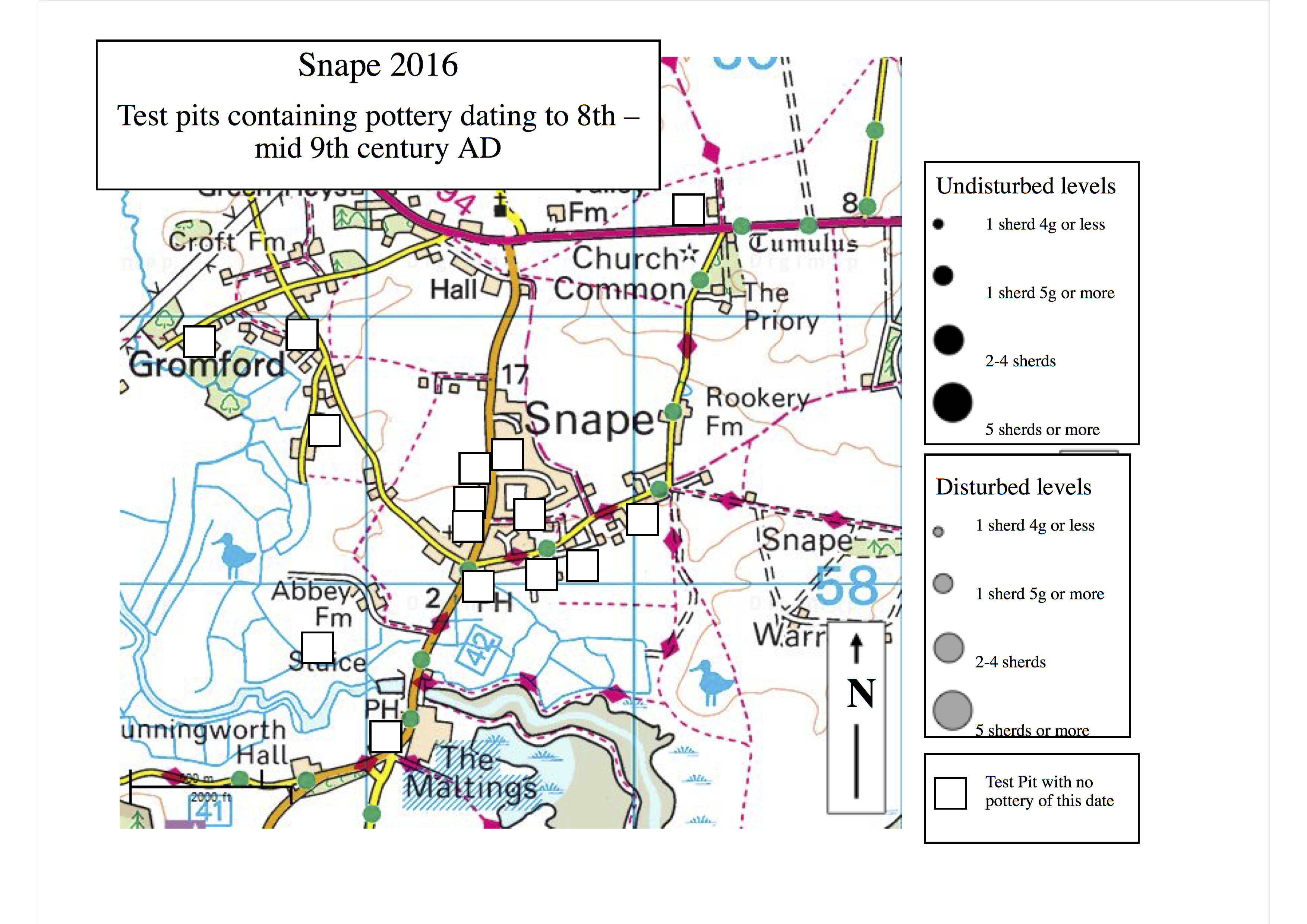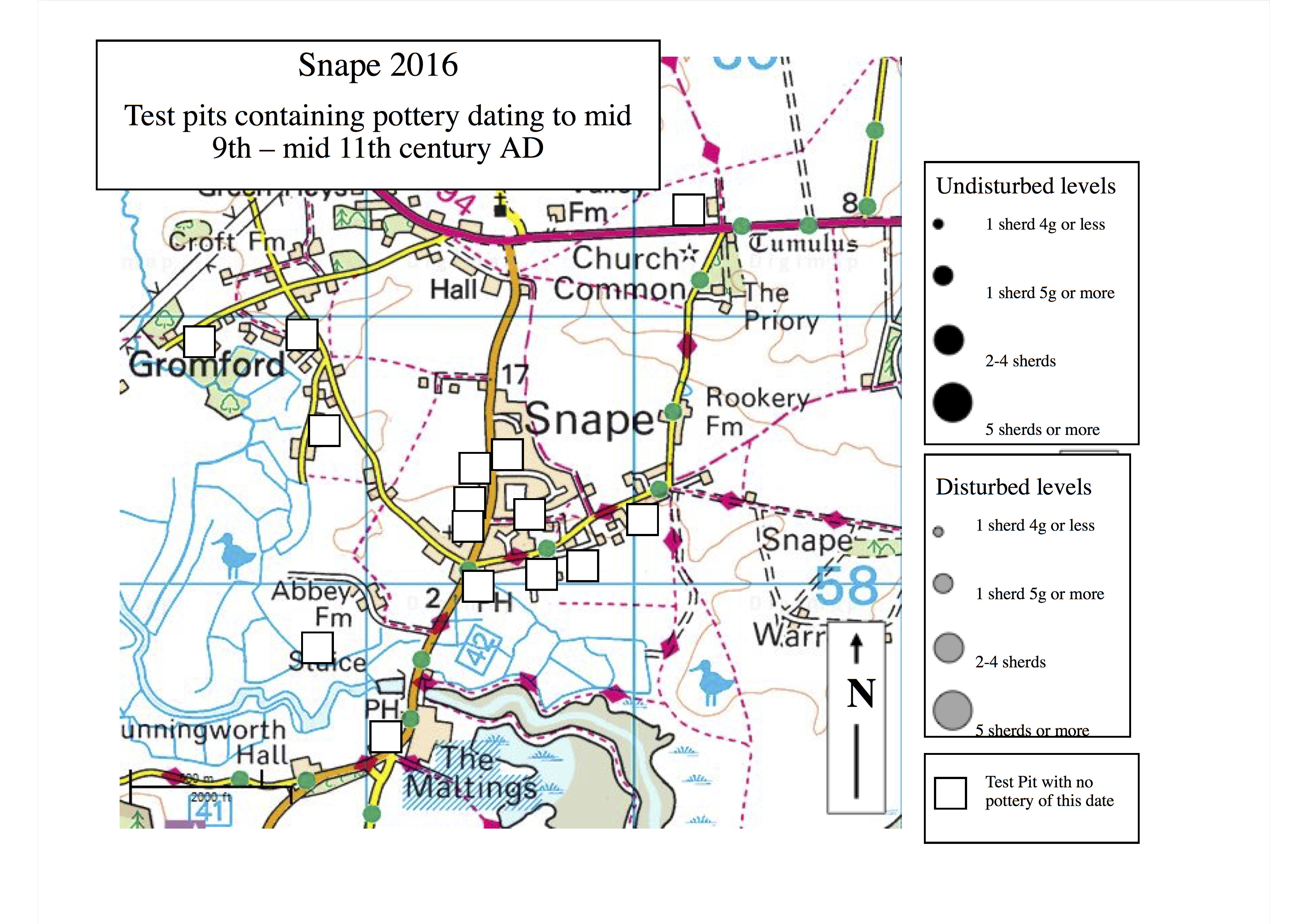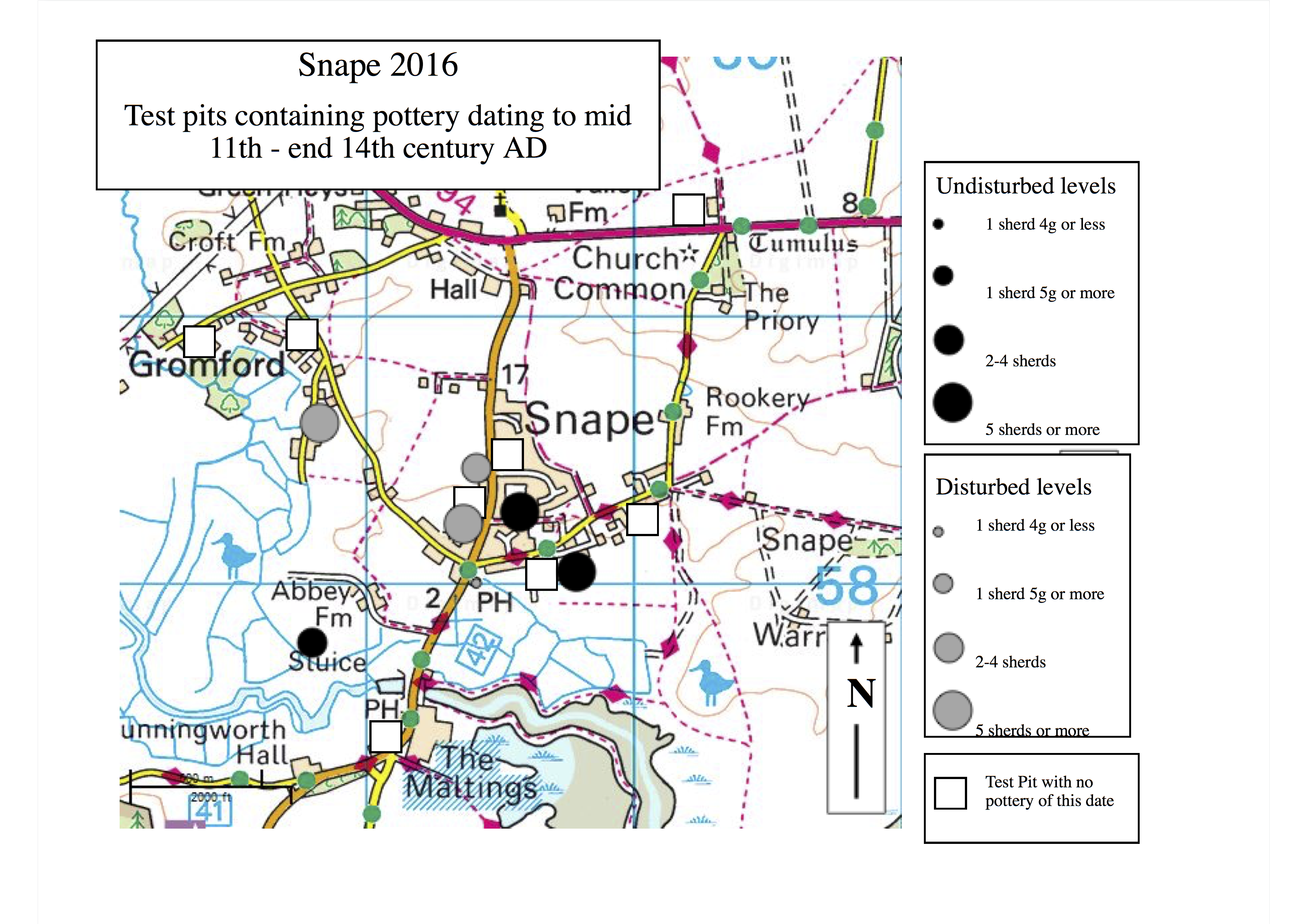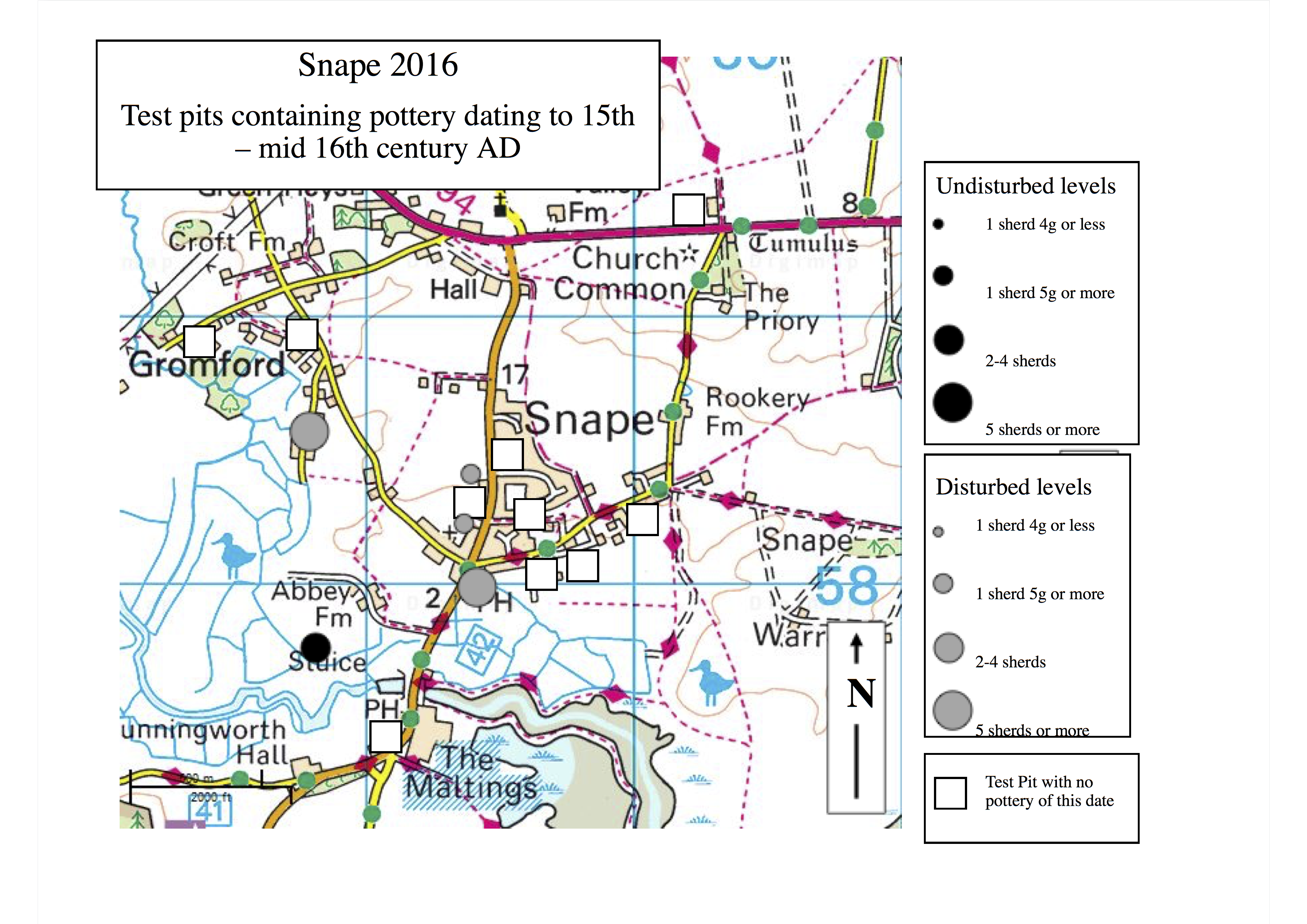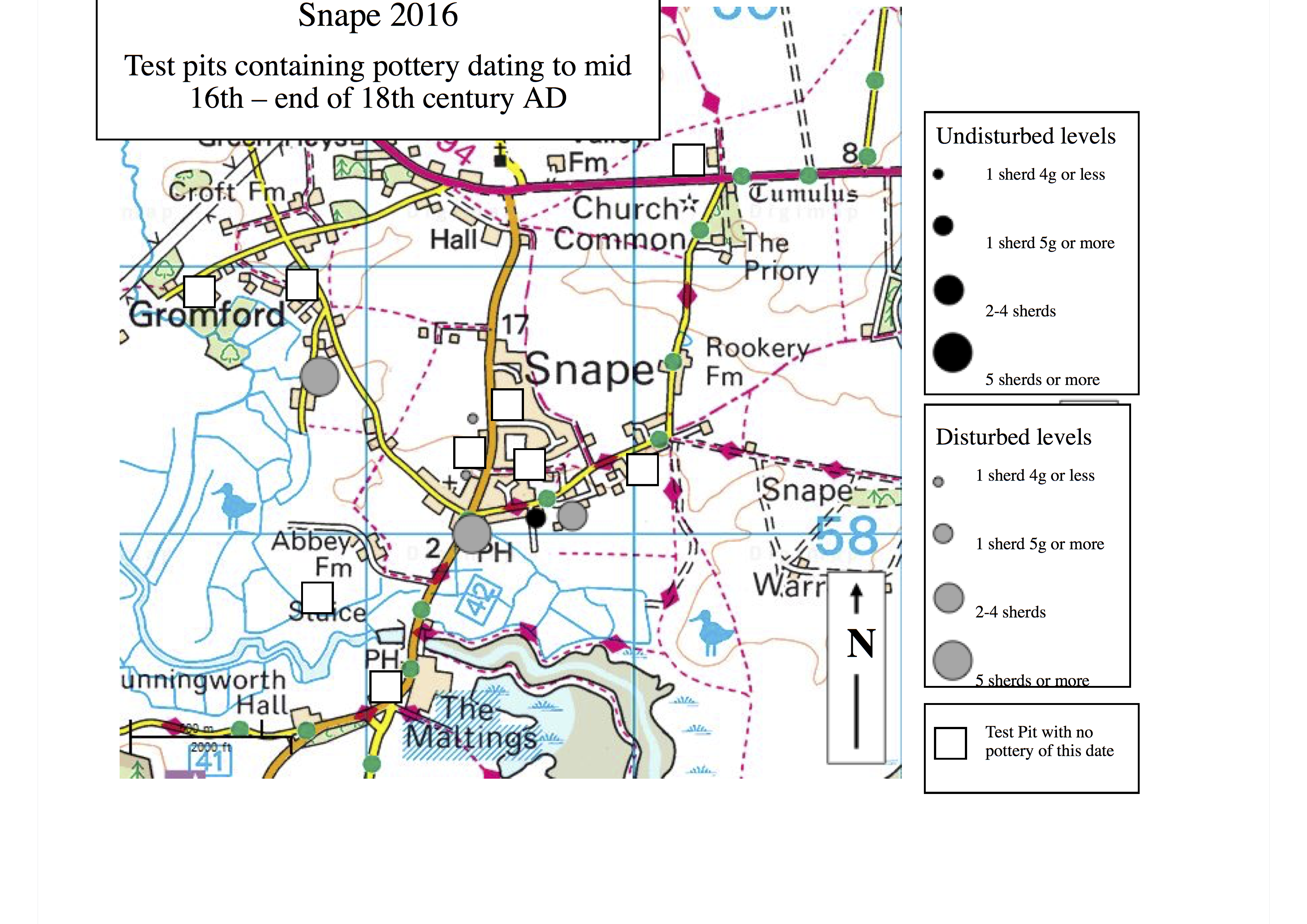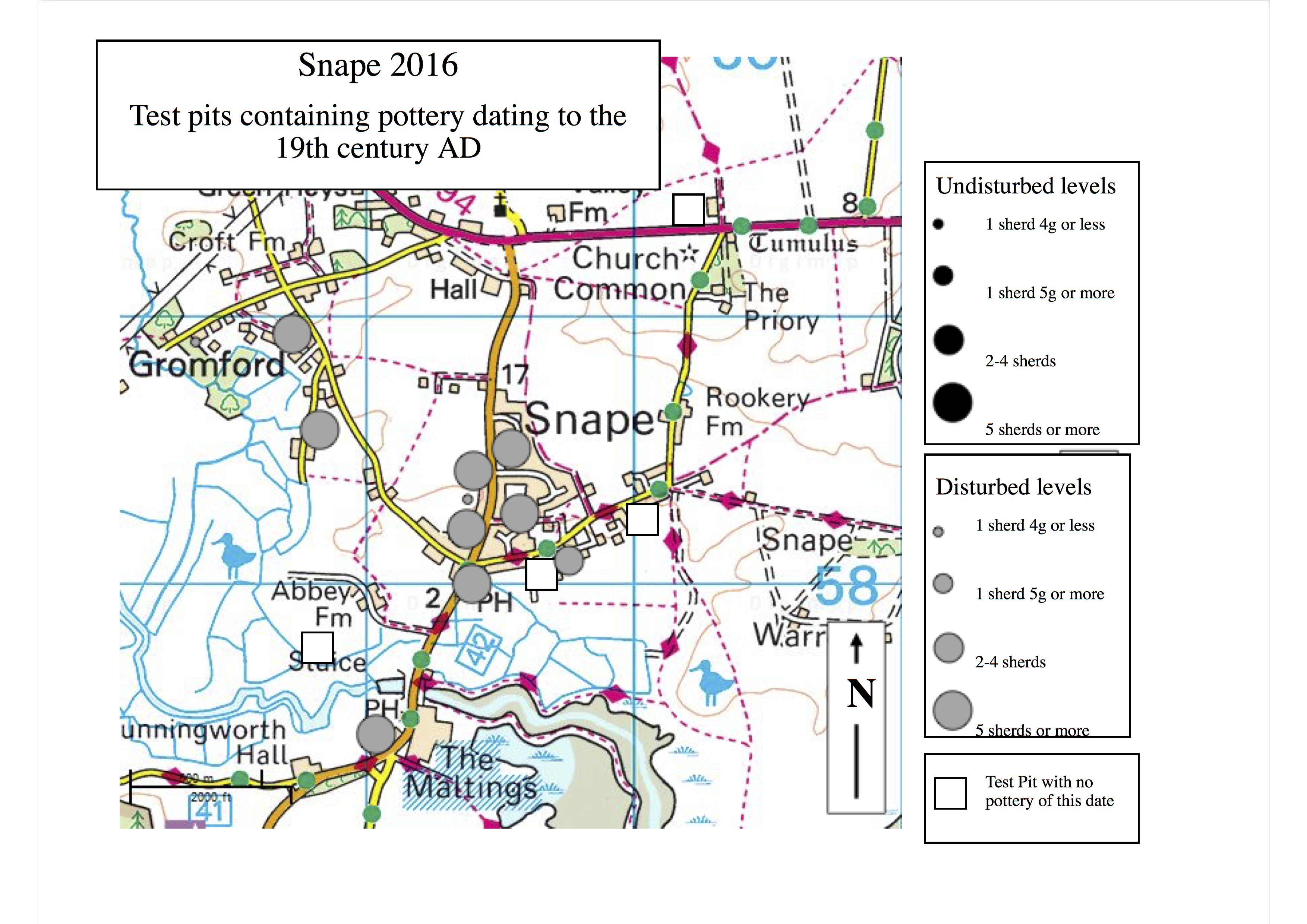- Screen Colours:
- Normal
- Black & Yellow
RESULTS FROM SNAPE TEST-PITTING
originally posted on 23rd May, 2016 [now slightly edited]
As part of the Heritage Lottery Funded Touching the Tide scheme a small archaeological ‘test pit’ excavation was carried out by Access Cambridge Archaeology [an outreach unit within the Department of Archaeology at the University of Cambridge] to discover how the area has developed over hundreds – even thousands – of years in the past.
[ACA had already undertaken fieldwalking in Snape with Touching the Tide in early 2014 which was focussed to the rear of the modern development opposite the Primary School in the north of Snape, that was swiftly followed up with two geophysical survey training days in a field 1km east of the village in the early Spring. Both of these were very successful in involving members of the local community, adding to the local knowledge of the area.]
Below are the results of the pottery analysis from this year's dig:
POTTERY FROM THE SNAPE TEST-PITS (SITE SNA/16)
Results
Test Pit 1 – Abbey Farm, Bridge Road
| TP | Cntxt | RB no | wt | EMW no | wt | LMT no | wt | date range |
| 1 | 1 | 1 | 2 | 1400-1550 | ||||
| 1 | 2 | 2 | 23 | 1100-1400 | ||||
| 1 | 3 | 1 | 1 | 1400-1550 | ||||
| 1 | 4 | 1 | 4 | 100-400 AD |
This test-pit produced very little pottery, with that which was found suggesting that the site had a marginal use, perhaps as fields, in the Roman and medieval periods.
Test Pit 2 – Kintail, Bridge Road
| TP | Cntxt | VIC no | wt | date range |
| 2 | 1 | 2 | 13 | 1800-1900 |
| 2 | 2 | 1 | 9 | 1800-1900 |
| 2 | 3 | 16 | 60 | 1800-1900 |
| 2 | 4 | 7 | 25 | 1800-1900 |
All the pottery from this test-pit is Victorian, indicating that the site was not used by people before that time.
Test Pit 3 – The Crown Pub, Bridge Road
| EMW | LMT | FREC | GRE | DW | SS | EST | VIC | |||||||||||
| TP | Cntxt | no | wt | no | wt | no | wt | no | wt | no | wt | no | wt | no | wt | no | wt | date range |
| 3 | 1 | 2 | 19 | 1800-1900 | ||||||||||||||
| 3 | 2 | 1 | 8 | 1 | 5 | 1 | 5 | 6 | 38 | 1400-1900 | ||||||||
| 3 | 3 | 1 | 5 | 1400-1550 | ||||||||||||||
| 3 | 4 | 1 | 1 | 1 | 1 | 1 | 5 | 6 | 22 | 1550-1900 | ||||||||
| 3 | 5 | 1 | 2 | 2 | 6 | 1 | 5 | 1 | 1 | 2 | 7 | 1100-1900 | ||||||
| 3 | 6 | 1 | 6 | 1 | 4 | 1 | 4 | 1400-1900 | ||||||||||
The pottery from this test-pit shows that the site was probably occupied in the late medieval period, but then seems to have had a more marginal use during the 17th – 18th centuries.
Test Pit 4 – Marsh Cottage, Priory Road
| TP | Cntxt | GRE no | wt | date range |
| 4 | 7 | 1 | 5 | 1550-1600 |
This test-pit produced just one sherd of pottery, of 16th century date, suggesting that the site had a marginal use at that time, but has otherwise never been occupied.
Test Pit 5 – 3 Blyth Houses, Church Road
| TP | Cntxt | EMW no | wt | LMT no | wt | WCS no | wt | VIC no | wt | date-range |
| 5 | 1 | 1 | 2 | 1 | 3 | 1100-1700 | ||||
| 5 | 2 | 1 | 5 | 6 | 38 | 1100-1900 | ||||
| 5 | 3 | 1 | 7 | 1 | 4 | 1400-1900 | ||||
| 5 | 4 | 2 | 6 | 4 | 8 | 1100-1900 | ||||
| 5 | 5 | 1 | 10 | 5 | 7 | 1100-1900 | ||||
| 5 | 6 | 1 | 1 | 1 | 1 | 1100-1900 | ||||
| 5 | 7 | 1 | 1 | 1800-1900 |
The pottery from this test-pit shows that the site was occupied in the earlier medieval period (12th – 14th centuries), but then seems to have lain largely disused until the Victorian era.
Test Pit 6 – Honeysuckle Cottage, Church Road
| TP | Cntxt | EMW no | wt | HED no | wt | GRIM no | wt | VIC no | wt | date range |
| 6 | 2 | 1 | 1 | 6 | 8 | 1100-1900 | ||||
| 6 | 3 | 1 | 6 | 4 | 12 | 1100-1900 | ||||
| 6 | 4 | 1 | 7 | 6 | 9 | 1200-1900 | ||||
| 6 | 5 | 3 | 30 | 1 | 8 | 1100-1400 |
The pottery from this test-pit shows that the site was occupied in the earlier medieval period (12th – 14th centuries), but then seems to have been disused until the Victorian era.
Test Pit 7 – 5 Blyth Houses, Church Road
| TP | Cntxt | VIC no | wt | date range |
| 7 | 2 | 1 | 1 | 1800-1900 |
This test-pit produced just one sherd of Victorian pottery, indicating that the site was not used by people before that time.
Test Pit 8 – 7 Blyth Houses, Church Road
| TP | Cntxt | EMW no | wt | LMT no | wt | GRE no | wt | VIC no | wt | date range |
| 8 | 1 | 2 | 2 | 1800-1900 | ||||||
| 8 | 2 | 1 | 2 | 7 | 21 | 1800-1900 | ||||
| 8 | 3 | 1 | 1 | 1800-1900 | ||||||
| 8 | 4 | 1 | 1 | 1550-1600 | ||||||
| 8 | 5 | 3 | 18 | 1 | 1 | 1100-1900 | ||||
| 8 | 6 | 1 | 5 | 2 | 6 | 1400-1900 |
This test-pit produced mainly Victorian pottery, with the other material suggesting that the site had a marginal use, perhaps as fields, in the medieval period.
Test Pit 9 – 1 The Glebes
| TP | Cntxt | VIC no | wt | date range |
| 9 | 2 | 5 | 12 | 1800-1900 |
| 9 | 4 | 1 | 1 | 1800-1900 |
| 9 | 5 | 1 | 6 | 1800-1900 |
All the pottery from this test-pit is Victorian, indicating that the site was not used by people before that time.
Test Pit 10 – Priory Bar, Priory Road — No pottery excavated
Test Pit 11 – Friston Lodge, Saxmundham Road — No pottery excavated
Test Pit 12 – Underwood, Gromford Lane
| TP | Cntxt | VIC no | wt | date range |
| 12 | 3 | 1 | 4 | 1800-1900 |
| 9 | 6 | 1 | 6 | 1800-1900 |
All the pottery from this test-pit is Victorian, indicating that the site was not used by people before that time.
Test Pit 13 – 5 Squirrel Cottages, Cundle Green Lane
| TP | Cntxt | EMW no | wt | LMT no | wt | GRE no | wt | SWSG no | wt | VIC no | wt | date range |
| 13 | 1 | 1 | 2 | 3 | 12 | 2 | 23 | 22 | 61 | 1100-1900 | ||
| 13 | 2 | 1 | 4 | 2 | 3 | 21 | 42 | 1100-1900 | ||||
| 13 | 3 | 2 | 5 | 1800-1900 | ||||||||
| 13 | 4 | 5 | 18 | 1 | 2 | 3 | 12 | 23 | 55 | 1100-1900 | ||
| 13 | 5 | 2 | 6 | 1 | 28 | 2 | 4 | 10 | 22 | 1100-1900 | ||
| 13 | 6 | 4 | 10 | 7 | 37 | 3 | 3 | 1100-1900 | ||||
| 13 | 7 | 3 | 6 | 1 | 10 | 1 | 7 | 2 | 8 | 1100-1900 | ||
| 13 | 8 | 2 | 31 | 1800-1900 |
The pottery from this test-pit shows that the site was occupied throughout the medieval period and into the 16th century, but it then seems to have been disused until the Victorian era.
Test Pit 14 – Fir Tree Farm, Priory Road
| TP | Cntxt | EMW no | wt | HED no | wt | GRE no | wf | VIC no | wt | date range |
| 14 | 1 | 2 | 4 | 1 | 2 | 1100-1900 | ||||
| 14 | 2 | 3 | 24 | 1 | 1 | 1100-1900 | ||||
| 14 | 3 | 2 | 10 | 2 | 2 | 1 | 2 | 1100-1900 | ||
| 14 | 4 | 4 | 9 | 1 | 1 | 1100-1600 | ||||
| 14 | 5 | 10 | 29 | 1100-1400 | ||||||
| 14 | 6 | 24 | 98 | 2 | 13 | 1100-1400 |
The pottery from this test-pit shows that the site was occupied in the earlier medieval period (12th – 14th centuries), but then seems to have been largely disused until the Victorian era.
Test Pit 15 – Holly Lodge, Wadd Lane
| TP | Cntxt | VIC no | wt | date range |
| 15 | 1 | 1 | 4 | 1800-1900 |
This test-pit produced just one sherd of Victorian pottery, indicating that the site was not used by people before that time.
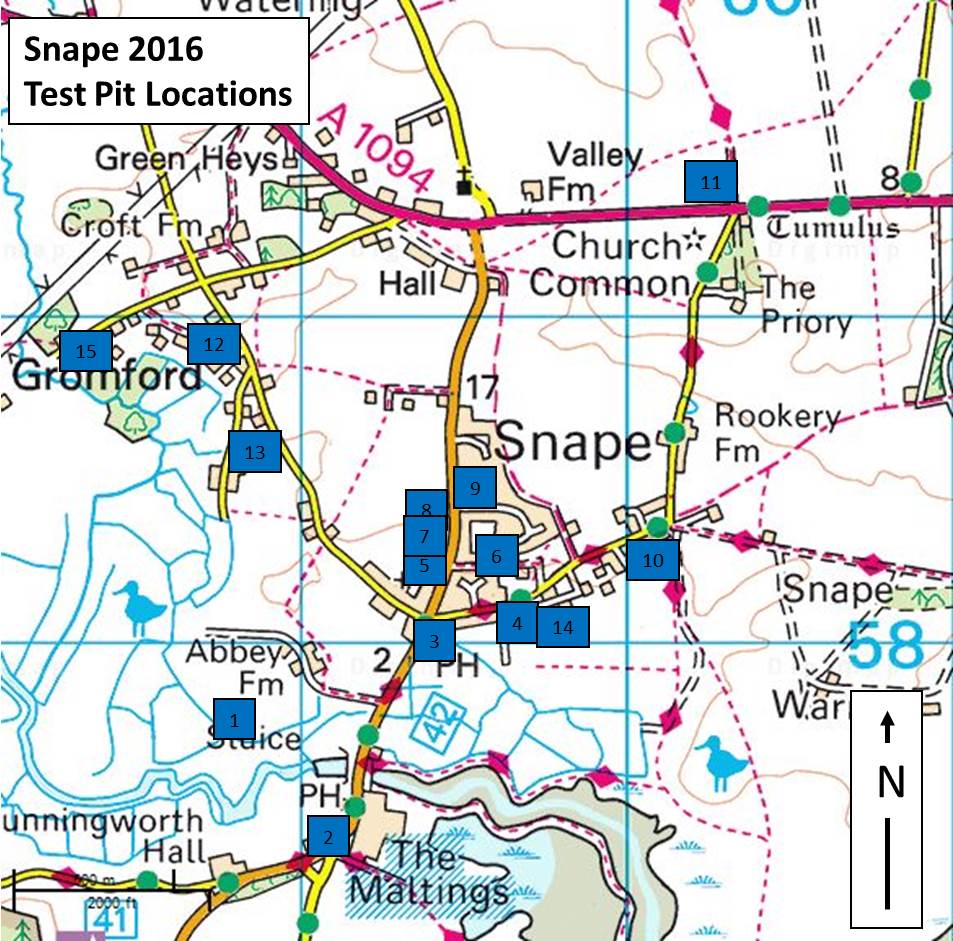
KEY TO
POTTERY TYPES
RB: Roman
All Roman wares
EMW: Early Medieval Sandy Ware, 1100-1400
Hard fabric with plentiful quartz sand mixed in with the clay. Manufactured at a wide range of generally unknown sites all over eastern England. Mostly cooking pots, but bowls and occasionally jugs also known.
HED: Hedingham Ware, late 12th – 14th century
Fine orange/red glazed pottery, made at Sible Hedingham in Essex. The surfaces of the sherds have a sparkly appearance due to there being large quantities of mica, a glassy mineral, in the clay. Pots usually glazed jugs.
GRIM: Grimston Ware
Made at Grimston, near King’s Lynn. It was made from a sandy clay similar with a slight ‘sandpaper’ texture. The clay is usually a dark bluish-grey colour, sometimes with a light-coloured buff or orange inner surface. It was made between about AD 1080 and 1400. All sorts of different pots were made, but the most common finds are jugs, which usually have a slightly dull green glaze on the outer surface.
LMT: Late Medieval Ware
Hard, reddish-orange pottery with lots of sand mixed in with the clay. Made from about 1400–1550 in lots of different places in East Anglia. Used for everyday pottery such as jugs and large bowls, and also large pots (‘cisterns’) for brewing beer.
GRE: Glazed Red Earthenwares
Fine sandy earthenware, usually with a brown or green glaze, usually on the inner surface. Made at numerous locations all over England. Occurs in a range of practical shapes for use in the households of the time, such as large mixing bowls, cauldrons and frying pans. It was first made around the middle of the 16th century, and in some places continued in use until the 19th century.
FREC: Frechen Stoneware, 1550-1750
Hard, grey German stoneware with a speckled brown and grey salt glaze.
DW: Delft ware
The first white-glazed pottery to be made in Britain. Called Delft ware because of the fame of the potteries at Delft in Holland, which were amongst the first to make it. Soft, cream coloured fabric with a thick white glaze, often with painted designs in blue, purple and yellow. First made in Britain in Norwich around AD1600, and continued in use until the 19th century. The 17th century pots were expensive table wares such as dishes or bowls, but by the 19th century, better types of pottery was being made, and it was considered very cheap and the main types of pot were such as chamber pots and ointment jars.
WCS: Cologne Stoneware
Hard, grey pottery made in the Rhineland region of Germany from around 1600 onwards. Usually has lots of ornate moulded decoration, often with blue and purple painted details. Still made today, mainly as tourist souvenirs.
SS: Staffordshire Slipware, made between c.1640 and 1750
This was the first pottery to be made in moulds in Britain since Roman times. The clay fabric is usually a pale buff colour, and the main product was flat dishes and plates, but cups were also made. These are usually decorated with thin brown stripes and a yellow glaze, or yellow stripes and a brown glaze.
EST: English Stoneware
Very hard, grey fabric with white and/or brown surfaces. First made in Britain at the end of the 17th century, usually for inn tankards, then became very common in the 18th and 19th century, particularly for mineral water or ink bottles and beer jars.
SWSG: White Salt-Glazed Stoneware
Delicate white pottery made between 1720 and 1780, usually for tea cups and mugs. Has a finely pimpled surface, like orange peel.
VIC: ‘Victorian’
A wide range of different types of pottery, particularly the cups, plates and bowls with blue decoration which are still used today. First made around 1800.
